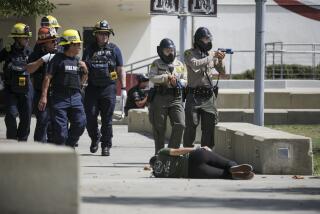State Takes Hands-Off Policy on Cellphones
SACRAMENTO — California will become the fourth state in the country to ban motorists from holding cellphones while driving under legislation Gov. Arnold Schwarzenegger announced he will sign into law today.
The governor’s office said Thursday that the signing will take place in Oakland, ending a five-year campaign by Sen. Joe Simitian (D-Palo Alto) to outlaw one of the most common distractions of California drivers.
Under the law, which will take effect in July 2008, Californians risk a minimum $20 fine for driving while yakking into a phone -- unless they are using a headset, speaker phone, ear bud or some other technology that frees both hands while they talk. Drivers in emergency situations would be exempt.
“Public safety is the governor’s No. 1 priority,” said Schwarzenegger spokeswoman Margita Thompson, “and this bill will make the streets and highways of California safer by ensuring that drivers have both hands available for driving.”
The bill passed both legislative bodies in late August -- the Assembly 50-28, and the Senate 21-16. In both houses, the measure passed with largely Democratic support and the votes of a few Republicans.
Although 38 state legislatures considered bills to minimize driving distractions such as cellphones this year, only New York, New Jersey, Connecticut and the District of Columbia have banned drivers from using hand-held cellphones.
It took Simitian five attempts to get enough support in the Legislature to pass the bill, but Schwarzenegger warmed to the idea quickly.
In a July online interview in which a reporter asked questions solicited from the public, the governor said he had warned his 16-year-old daughter that she would lose her driving privileges if he caught her driving with her cellphone in her hands.
“I sometimes follow her to make sure that she doesn’t make that mistake. If she makes that mistake, then I will take the car away from her, and she will drive with the bus, because it’s inexcusable.”
Though the only official opponent of the bill was the Sprint-Nextel cellular phone company, several lawmakers argued that the act of conversing -- not of holding a phone -- is the real distraction to drivers.
They also argued that children, the radio, pets, hamburgers and sodas are all as likely to divert drivers’ attention as cellphones.
Some Republican lawmakers criticized the bill, SB1613, as “nanny government.”
“What’s next -- helmets while you’re riding a horse? Airbags in the bathtub?” said Assemblyman Doug La Malfa (R-Richvale) during the Assembly floor debate last month.
But Simitian argued that the traffic safety risk of cellphone use while driving is “measurable and significant.” In a letter sent Monday to the governor, the senator pointed to academic research in the Accident Analysis and Prevention journal that concluded that the risk of death is nine times greater for drivers who use a cellphone while driving.
California Highway Patrol data from 2004 show police reports for 775 accidents in which a driver at fault was using a hand-held cellphone.
There were only 28 reports of accidents in which drivers using hands-free phones were to blame. Preliminary data from last year show a similar pattern.
“When you’re on your cellphone,” wrote Simitian, “you are distracted at three different levels: aurally, visually and mentally. But what the hands-free requirement can and does accomplish is that
Simitian said he delayed implementation of the bill until July 2008 to help win the support of reluctant lawmakers, give the Department of Motor Vehicles time to update its drivers’ handbook and give fair warning to motorists.
The CHP is expected to spend roughly $500,000 a year, starting next year, to educate motorists about the new law.
The idea for the bill came to Simitian before he was elected to the Assembly in 2000, when someone asked him at a candidates forum about a cellphone ban on drivers.
“Almost everybody I meet has a horror story they want to tell me,” he said.
In addition to motorists in emergencies, the legislation does not apply to people using two-way radios in farm vehicles and tow trucks, although that exemption disappears in 2011.
And although the base fine for a violation is $20, cited driverswill pay more because of administrative charges tacked on by cities and counties. The base fine rises to $50 for subsequent offenses.
Simitian said he expected the pending ban in a state with 23 million licensed drivers to lead to better and cheaper hands-free cellphone technology.
Most cellphone makers now include such equipment with their phones.
California may also spur similar bans across the country, said Matt Sundeen, a transportation expert with the National Conference of State Legislatures.
Dozens of states recently have pondered bills aimed at minimizing driver distraction, such as banning unsecured pets in cars and prohibiting younger drivers from using cellphones.
“Clearly, Californians are attached to their cars and attached to their phones,” said Sundeen, “and if a state that big passes a law it can have some inspiration on other states.”
More to Read
Get the L.A. Times Politics newsletter
Deeply reported insights into legislation, politics and policy from Sacramento, Washington and beyond. In your inbox three times per week.
You may occasionally receive promotional content from the Los Angeles Times.










